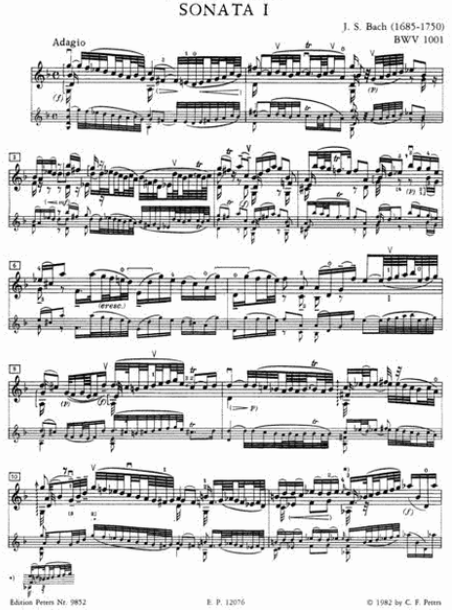
Happy Present Meet
Bach 6 Sonatas and Partitas for Violin Solo (Rostal, M)
Contents:
Sonata No.1 in G minor, BWV 1001
1.Adagio
2.Fuga (Allegro)
3.Siciliana
4.Presto
Partita No.1 in B minor, BWV 1002
1.Allemanda
2.Corrente
3.Sarabande
4.Tempo di Borea
Sonata No.2 in A minor, BWV 1003
1.Grave
2.Fuga
3.Andante
4.Allegro
Partita No.2 in D minor, BWV 1004
1.Allemanda
2.Corrente
3.Sarabanda
4.Giga
5.Ciaccona
Sonata No.3 in C major, BWV 1005
1.Adagio
2.Fuga
3.Largo
4.Allegro assai
Partita No.3 in E major, BWV 1006
1.Preludio
2.Loure
3.Gavotte en rondeau
4.Menuet I
5.Menuet II
6.Bourree
7.Gigue
Sonata No. 1 G-min BWV 1001 - 1. Mouvment
arr. for String Quartet
Bach's Sei Solo a Violino senza Basso accompagnato, the set of three Sonatas and three Partitas for unaccompanied violin, were completed by 1720. Perhaps seeded as early as 1703, they were ultimately fruits of his years employed as Kapellmeister at the court in Köthen where his employer Prince Leopold of Anhalt-Köthen, a Calvinist with little requirement for liturgical music and also a keen musician, encouraged Bach to write much instrumental music for public and private entertainment. Nothing written before approached the complexity, expressive range and scale of this music, from the volleys of chords and rhythmic intricacy of the B minor Partita's opening Allemanda and the endlessly inventive elaboration of the same work's variant 'doubles' to the vastness of the D minor Partita's concluding Ciaccona, possibly the longest stand-alone movement written to that point, which contains worlds of contrast in its 64 variants of the opening bars. Reportedly a fine violinist himself, Bach completely redefined virtuosic and expressive violinistic possibility in these works. This Urtext edition by Max Rostal from Edition Peters is a cornerstone of any violinist's library.
바흐의 무반주 바이올린을 위한 3개의 소나타와 3개의 파르티타로 구성된 Sei Solo a Violino senza Basso accompagnato는 1720년에 완성되었습니다. 아마도 1703년 초에 시작되었을 것으로 보이며, 궁극적으로는 그가 쾨텐 궁정에서 악장으로 재직하던 시절의 결실이었습니다. 그의 고용주인 안할트-쾨텐의 레오폴드 공은 전례 음악에 대한 요구가 거의 없었지만 열렬한 음악가이기도 했습니다. 그는 바흐에게 대중과 개인적 오락을 위해 많은 기악을 작곡하도록 격려했습니다. 이전에는 이 음악의 복잡성, 표현력, 그리고 규모에 필적할 만한 작품은 없었습니다. B단조 파르티타의 도입부 알레만다의 화음과 리듬의 정교함, 그리고 같은 작품의 '더블' 변주곡에 대한 끝없는 창의성 넘치는 정교함, 그리고 D단조 파르티타의 마지막 악장인 차코나의 광대함에 이르기까지, 이 음악은 아마도 당시까지 작곡된 단독 악장 중 가장 긴 곡일 것이며, 도입부의 64개 변주곡은 대조적인 세계를 보여줍니다. 바흐 자신도 뛰어난 바이올리니스트였다고 알려진 그는 이 작품들을 통해 기교적이고 표현력 넘치는 바이올리니스트적 가능성을 완전히 새롭게 정의했습니다. 피터스 출판사에서 출간된 막스 로스탈의 이 원전판은 모든 바이올리니스트에게 필수적인 자료입니다.
편곡자 Rostal, M
작곡가 Bach, Johann Sebastian (1685-1750)

Bach 6 Sonatas and Partitas S.1001-1006 for Violin Solo (Galamian)
Vieuxtemps Violin Concerto No.5 in a minor Op.37 for Violin and Piano
Carl Flesch Scale System for Violin Solo
Haydn Violin Concerto No.1 in C major Hob.VIIa:1 for Violin and Piano (Carl Flesch)
Haydn Violin Concerto No.1 in C major Hob.VIIa:1 for Violin and Piano (Carl Flesch)
Paganini 24 Caprices Op.1 for Violin Solo (Galamian)
Bruch Violin Concerto No.1 in g minor Op.26 for Violin and Piano
Mendelssohn Violin Concerto in e minor Op.64 for Violin and Piano